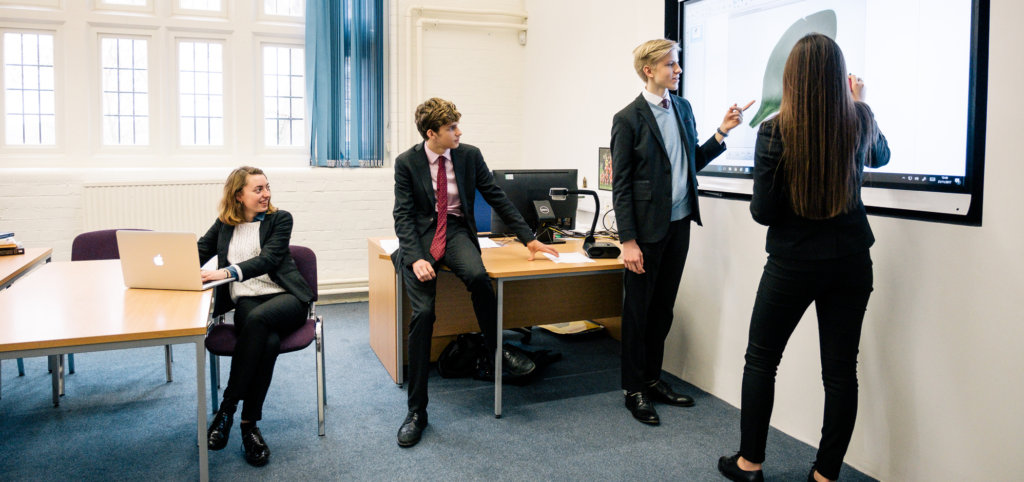Sixth Form pupil Maryam (I) was named as a runner up in the Medical Admissions and Global Clinical Network Student National Science Essay Competition at the beginning of the year.
Described as ‘academically gifted with an exemplary work ethic’ by her Housemistress Nicola Armstrong, this self-motivated and driven young scientist was one of just 18 individuals to receive recognition from thousands of entries.
Judged by Professor Alan Fenwick OBE, Emeritus Professor, Imperial College London, the competition encouraged aspiring scientists and clinicians to think critically about tackling global challenges and change.
Read her essay below.
HOW WILL DOCTORS PRACTICE MEDICINE IN 2031?
Marayam (I)
With science and technology advancing at such a rapid rate, it is only reasonable to start looking into the future and imagining what healthcare will look like in the years to come. Yet although 2031 is a mere nine years away from now, considering the exponential growth of medicine, a myriad of changes will have happened to the healthcare industry by then. First and foremost, healthcare will be centred around eliminating the root of the problem, rather than treating it as it progressively gets worse, and – as the famous parable goes – doctors will be “going upstream to tackle the guy throwing the people in the water”, rather than continuously trying to resuscitate the ones already drowning. 1 Ultimately, they will seek to transform the current “sick-care” 2 system into a healthcare system.
Alongside the obvious and inevitable digitalisation of the system, genetics will become the focal point of every medical treatment in the future. Genome sequencing will be the future doctors’ key to diagnosis and treatment. It is even likely that new-born babies – or even foetuses – will have their genomes sequenced as part of a mandatory procedure. This would allow doctors to re-sequence and compare their genomes upon every visit to observe any changes since their previous genome sequence. This will not only improve the specificity and the success rate of medical treatment and diagnosis, but also pinpoint the root of potential diseases, subsequently allowing to eradicate them from the very start through genetic engineering and CRISPR – which would be another flourishing branch of future medicine. All of this will be feasible through the prevailing technological advances, as well as the body of data and genome sequences that will have accumulated by 2031 since the initial Human Genome Project, allowing more accurate comparison and mapping.
Stem cell therapy is another promising field for future healthcare practice. As discussed in the previous paragraph, the use of stem cells 3 will tailor therapy and treatment specifically to the patient: not only will blood transplants and organ donations become more readily available through SCNT 4, iPSC and ASC lab cultures, but they will also be unique to the patient. Likewise, with the changing social ethics and the role of women in society – with pro- choice becoming increasingly legal – stem cell therapy will become less of an ethical concern, and there will be more aborted embryos available for research and other therapeutic uses involving ESC.
Surgery is no exception to the exciting changes that are bound to occur. Surgeons might be expected to start using robotics to conduct complex surgery where scrupulous attention to detail is imperative. The human flaws and abilities of surgeons will be boosted and made metahuman through the aid of robotics and specialised control equipment, permitting surgeons to control the robots performing the surgery. This will lower the overall risk of the surgery whilst preventing damage to essential organs or blood vessels – neurosurgery being the primary cause for concern, where hemiplegia is considered mere collateral damage nowadays.
Artificial Intelligence could also make a debut in pharmacology, drug testing and development to give doctors yet another superpower. AI that can combine all the available information from the vast expanses of the internet and clinical databases with the individual genome sequences could evaluate the viability, safety, and optimum dosage of a drug for a unique individual’s specific condition, quickly and efficiently. This would consequently take personalised medicine and drug treatment to the next level.
Although economic and ethical issues might arise along the way, with the development and integration of new technological tools, healthcare proves to become highly advanced as we approach the next century, with the industry possibly overtaking banking and finance in its profitability and social value.
1 Linkedin.com. 2021. Upstream thinking: How to solve problems before they happen. [online] Available at: <https://www.linkedin.com/pulse/upstream-thinking-how-solve-problems-before-happen-katya-andresen> [Accessed 07 December 2021].
2 The Telegraph. 2021. More robots, less cancer, no diabetes. [online] Available at: <https://www.telegraph.co.uk/wellbeing/future-health/healthcare-predictions/> [Accessed 09 December 2021].
3 Daniel, E., 2021. Future of healthcare: What will medicine look like in 2040? [online] Verdict. Available at: <https://www.verdict.co.uk/future-of-healthcare/> [Accessed 10 December 2021].
4 Encyclopedia Britannica. 2021. somatic cell nuclear transfer | Definition, Steps, Applications, & Facts. [online] Available at: <https://www.britannica.com/science/somatic-cell-nuclear-transfer> [Accessed 11 December 2021].





